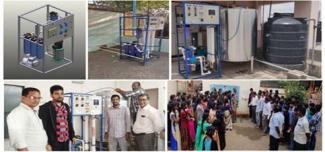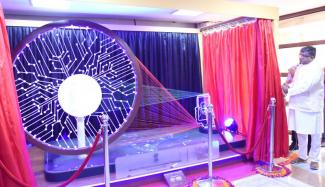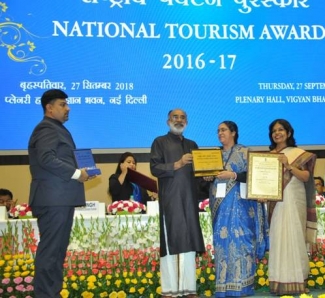
इस समाचार को हिन्दी में पढ़े आगे...
Innovative technologies by an IIT Kharagpur-based center of technological excellence focusing on water purification have helped deliver clean and safe drinking water and also manage floods in several states across the country.
An efficient, low-cost, nano-filtration-based technology by The Centre for Technological Excellence in Water Purification (CTEWP) housed in IIT Kharagpur has ensured access to safe and clean drinking water free of heavy metals for 25,000 people in three different locations in Telangana and Andhra Pradesh.
The prototype of the highly compact vertical modular nanofiltration membrane system designed for removal of heavy metals from the groundwater was developed by the Membrane Separations Laboratory, CSIR-Indian Institute of Chemical Technology (IICT), with support from the Department of Science and Technology (DST) Water Technology Initiative (WTI). With a capacity of 100 - 300 Litre per hour(L/h), the system based on a membrane technically called hydrophilized polyamide membrane removes heavy metals such as Iron from groundwater. It consists of pumps that force water first through a prefilter assembly to remove suspended solids, color, and odour and then spiral wound membrane modules that separate heavy metals. It gives purified permeate of reasonable total dissolved solids (TDS) devoid of contaminants such as Iron, Arsenic, or excess hardness. Ultraviolet light is provided at the end to disinfect any pathogens that may be present in the tank or pipelines.
The water that children of a primary school in North Guwahati, Assam, drank was highly contaminated with Iron, high COD, and emanated a foul smell. Now with access to clean drinking water from a water treatment plant (300 L/h) developed by IIT Guwahati installed in the school, the students of Lathiabagicha Primary School are relieved. This plant was designed and fabricated based on chemical less electrocoagulation technique. Supported by DST, it is capable of treating Total Soluble Solvent (TSS), Chemical Oxygen Demand (COD), Biological Oxygen Demand (BOD), Iron and Arsenic from contaminated drinking water to below BIS limit. More than 120 students of the school, as well as the villagers of Lathiabagicha (more than 500), are now assured that quenching their thirst will not affect their health. The treated water is also used for cooking mid-day meals in the school.
The CSIR-IICT's team has also developed a simple, inexpensive, hand pump operated hollow fibre ultrafiltration system that is easy to operate, has high mobility, occupies less space, and is lightweight. The technology supported by DST was based on membranes called polyethersulfone hollow fibers. The pressure generated by the hand pump to transport floodwater into the membrane module providing a driving force to facilitate the permeation of clarified and disinfected water through the porous membrane, while a small chlorine cartridge installed at the membrane outlet leaches free chlorine to tackle any secondary contamination.A total of 24 water plants were installed during recent floods in Karnataka, Maharashtra, Kerala, Bihar, Odisha, and West Bengal to provide clean and safe drinking water to 50,000 people.
The solutions by the centre for water-related problems ranging from contamination by heavy metals to flood-related water problems would comprehensively help tackling health and disaster management challenges.
[For more details, Dr. Sirshendu De, Professor, Department of Chemical Engineering, IIT Kharagpur( 9434017363; [email protected]);Dr. S. Sridhar, Senior Principal Scientist, IICT Hyderabad (8790748674; email:[email protected]); Dr. Mihir Kumar Purkait, Professor, Department of Chemical Engineering, IIT Guwahati, mobile: 9954248807; email:[email protected] can be contacted.]
स्वच्छ पेयजल आपूर्ति और बाढ़ प्रबंधन जैसी पानी की समस्याओं के लिए प्रौद्योगिकी नवीन समाधान प्रदान करती है
भारतीय प्रौद्योगिकी संस्थान (आआईटी) खड़गपुर स्थित तकनीकी उत्कृष्टता केंद्र जल शुद्धिकरण पर ध्यान केंद्रित कर रहा है और इसने देश के कई राज्यों में स्वच्छ पेयजल आपूर्ति और बाढ़ के पानी के प्रबंधन की दिशा में अच्छा काम किया है।
आईआईटी खड़गपुर स्थित जल शुद्धिकरण तकनीकी उत्कृष्टता केंद्र (सीटीईडब्ल्यूपी) ने एक कुशल, कम लागत वाली नैनो फिल्टरेशन आधारित तकनीक विकसित की है जिसनें तेलंगाना और आंध्र प्रदेश में तीन अलग-अलग स्थानों पर 25 हजार लोगों की स्वच्छ पेयजल तक पहुंच सुनिश्चित की है। यह पानी भारी धातुओं से मुक्त है जो स्वास्थ्य के लिए काफी खतरनाक माने जाते हैं। मेम्ब्रेन सेपरेशन लेबोरेटरीज, सीएसआईआर-भारतीय रसायन प्रौद्योगिकी संस्थान (आईआईसीटी) ने विज्ञान और प्रौद्योगिकी विभाग (डीएसटी) जल प्रौद्योगिकी पहल (डब्ल्यूटीआई) के सहयोग से अत्यधिक कॉम्पैक्ट वर्टीकल मॉड्यूलर नैनोफिल्टरेशन मेम्ब्रेन सिस्टम का प्रोटोटाइप विकसित किया है जो भू-जल में मौजूद भारी धातुओं को हटाने का काम करता है। इसकी क्षमता एक घंटे में 100 से 300 लीटर पानी को साफ करने की है और यह टेक्नोलॉजी हाइड्रोफिलाइज्ड पॉलियामाइड मेम्बरेन प्रणाली पर आधारित है जो भूजल में मौजूद भारी धातु जैसे आयरन को हटाने में काफी मददगार है। इसमें ऐसे पंप होते हैं जो पानी को पहले प्रिफिल्टर असेंबली में बल पूर्वक भेजते हैं जहां उसमें मौजूद ठोस तत्व, रंग एवं गंध को हटाया जाता है और इसके बाद इसे स्पायरल वुंड मेम्बरेन मॉड्यूल से गुजारा जाता है जहां भारी धातुओं को हटाया जाता है। इस प्रक्रिया में आयरन, आर्सेनिक और पानी की अधिक कठोरता को समाप्त किया जाता है और अंत में पराबैंगनी प्रकाश की मदद से टैंक अथवा पाइपलाइनों में मौजूद रोगाणुओं के नष्ट किया जाता है।
असम के उत्तर गुवाहाटी के एक प्राथमिक स्कूल में बच्चे ऐसा पानी पीते थे जिसमें अत्यधिक आयरन और सीओडी पाया गया था तथा इससे बदबू भी आती थी लेकिन अब आईआईटी गुवाहाटी ने स्कूल में जलशोधन संयंत्र (300 लीटर प्रति घंटा) को स्थापित किया है और लाठियाबागीछा प्राइमरी स्कूल के बच्चों को पानी की पहले की समस्या से छुटकारा मिल गया है। इस संयंत्र को डीएसटी के सहयोग से रसायन मुक्त इलेक्ट्रोकोएग्यूलेशन तकनीक के आधार पर विकसित किया गया है और यह पानी में मौजूद आयरन और ऑर्सेनिक की मात्रा कम करने, उसमें कुल घुलित सॉल्वेंट, रासायनिक ऑक्सीजन डिमांड (सीओडी) जैविक ऑक्सीजन डिमांड (बीओडी) को बीआईएस की निर्धारित सीमा से नीचे लाने में सक्षम है।
स्कूल के 120 से अधिक छात्रों के साथ-साथ लाठियाबागीछा गांव के (500 से अधिक) लोग इस बात को लेकर आश्वस्त हैं कि वे साफ पानी पिएंगे और अब उनके स्वास्थ्य पर कोई दुष्प्रभाव नहीं पड़ेगा। इस शोधित जल का उपयोग स्कूल में दोपहर का भोजन पकाने में भी होता है।
सीएसआईआर-आईआईसीटी की टीम ने एक सरल, सस्ती हैंडपंप संचालित होलो फाइबर अल्ट्राफिल्ट्रेशन प्रणाली भी विकसित की है जो चलाने में आसान है तथा हल्की और कम जगह घेरती है। डीएसटी के तकनीकी सहयोग से इसे विकसित किया गया है और यह पॉलीइथर्सल्फ़ोन होलो फाइबर मेम्बरेन पर आधारित है। हैंडपंप द्वारा पैदा किए गए दवाब से बाढ़ का पानी मेम्बरेन मॉड्यूल में जाता है जहां इसे साफ तथा विसंक्रमित कर दिया जाता है और झिल्ली के बाहरी किनारे पर लगाया गया एक छोटा क्लोरीन बॉक्स पानी में मौजूद मुक्त क्लोरीन को साफ कर देता है। हाल ही में कर्नाटक, महाराष्ट्र, केरल, बिहार, ओडिशा और पश्चिम बंगाल में बाढ़ के दौरान ऐसे कुल 24 जल संयंत्रों को स्थापित किया गया था ताकि 50,000 लोगों को स्वच्छ और सुरक्षित पेयजल उपलब्ध कराया जा सके।
इस केंद्र की ओर से विकसित की गई नई तकनीकों की मदद से पानी में पाए जाने वाली भारी धातुओं को हटाने और बाढ़ के पानी को पीने योग्य बनाने में मदद मिलेगी जिससे स्वास्थ्य एवं आपदा प्रबंधन चुनौतियों से निपटने में मदद मिलेगी।
[ इस विषय में अधिक जानकारी के लिए, डॉ. सरशेंदु डे, प्रोफेसर, केमिकल इंजीनियरिंग विभाग, आईआईटी खड़गपुर (943473636; [email protected]); डॉ. एस. श्रीधर, वरिष्ठ प्रधान वैज्ञानिक, आईआईसीटी हैदराबाद (8790748674; ईमेल: [email protected]); डॉ. मिहिर कुमार पुरकैत, प्रोफेसर, केमिकल इंजीनियरिंग विभाग, आईआईटी गुवाहाटी, मोबाइल: 9954248807; ईमेल: [email protected] से संपर्क किया जा सकता है]










